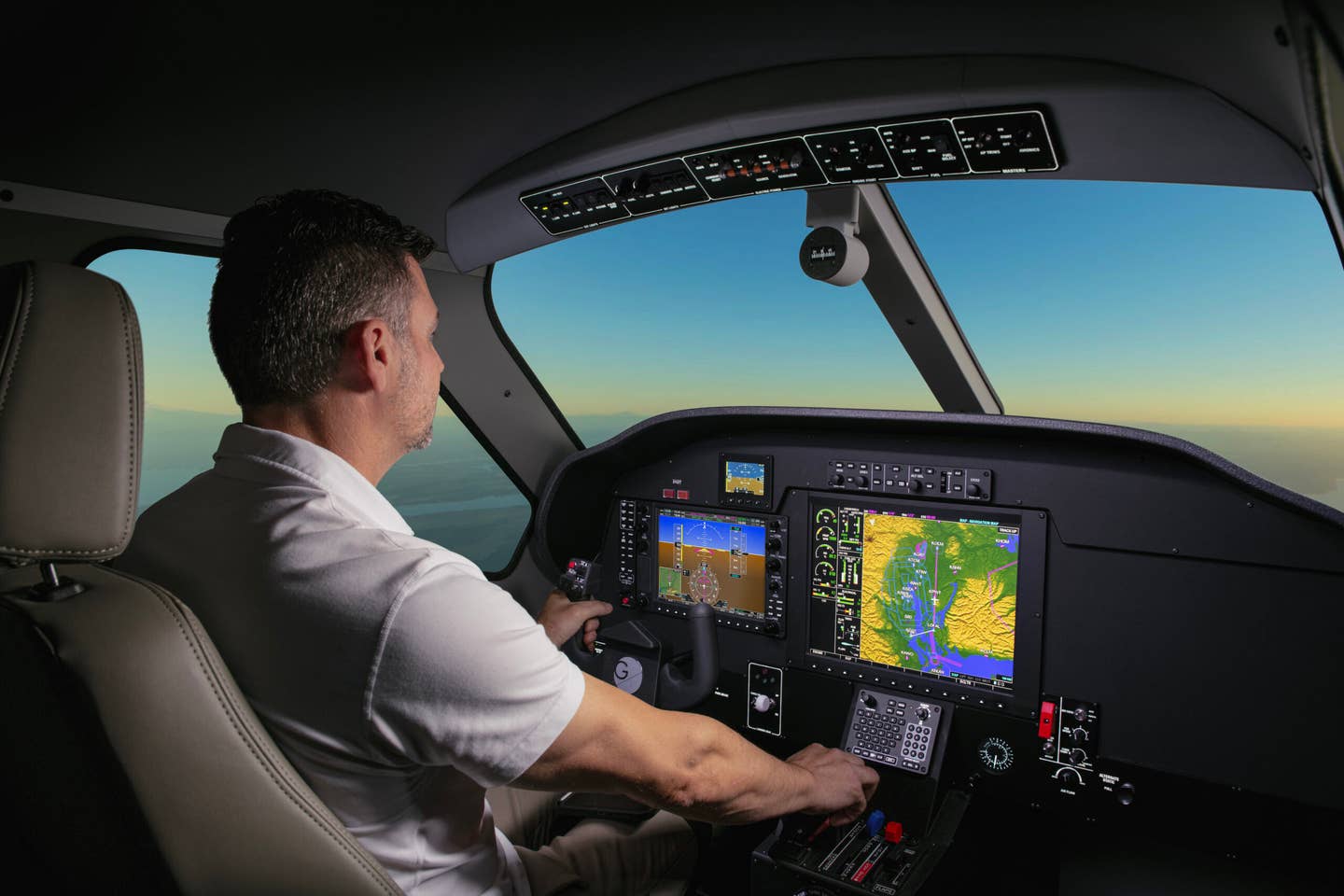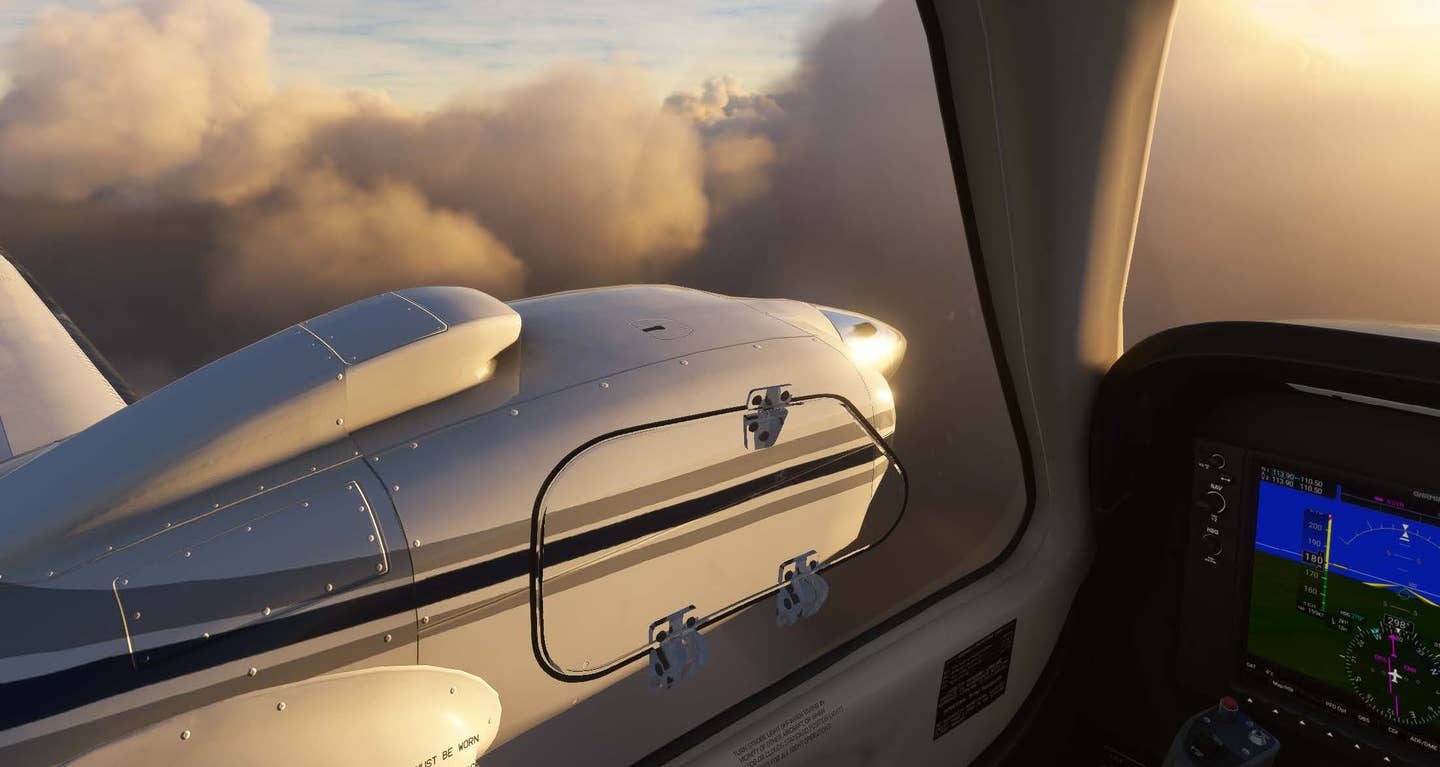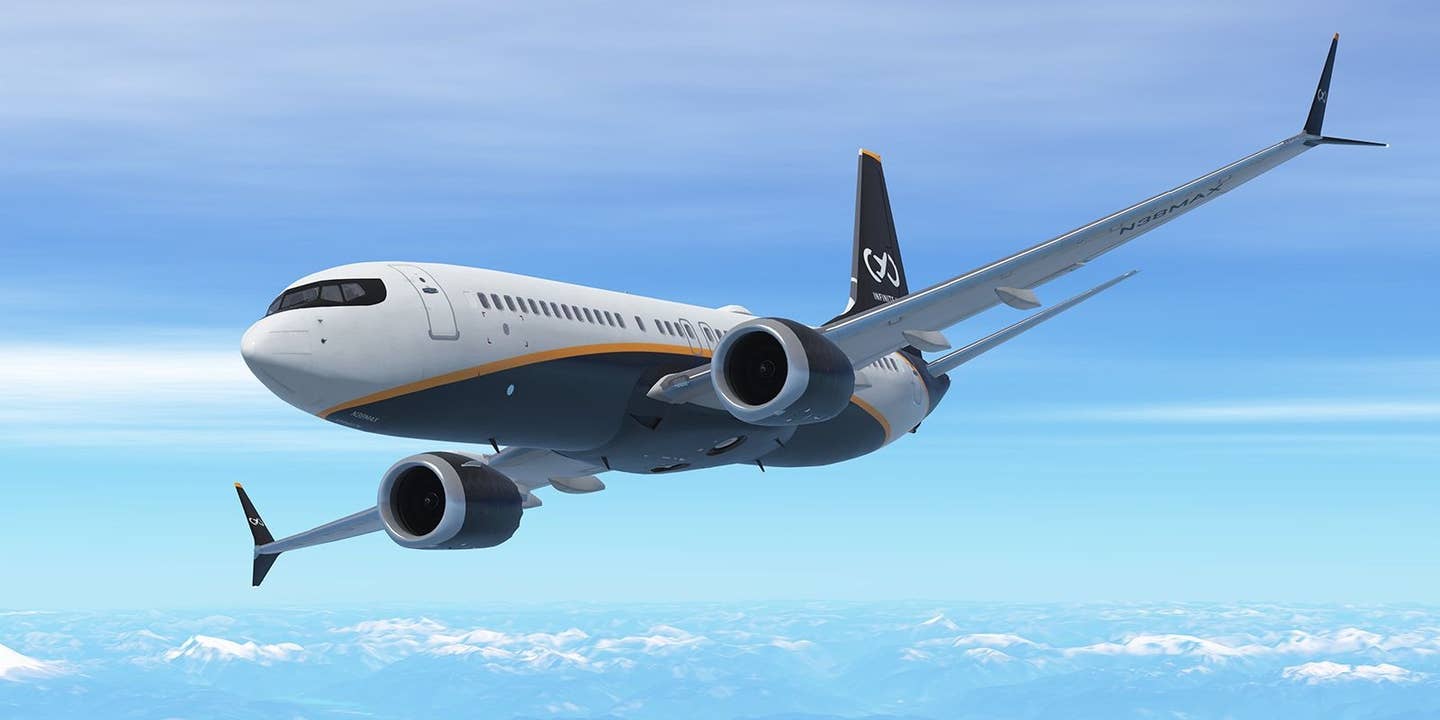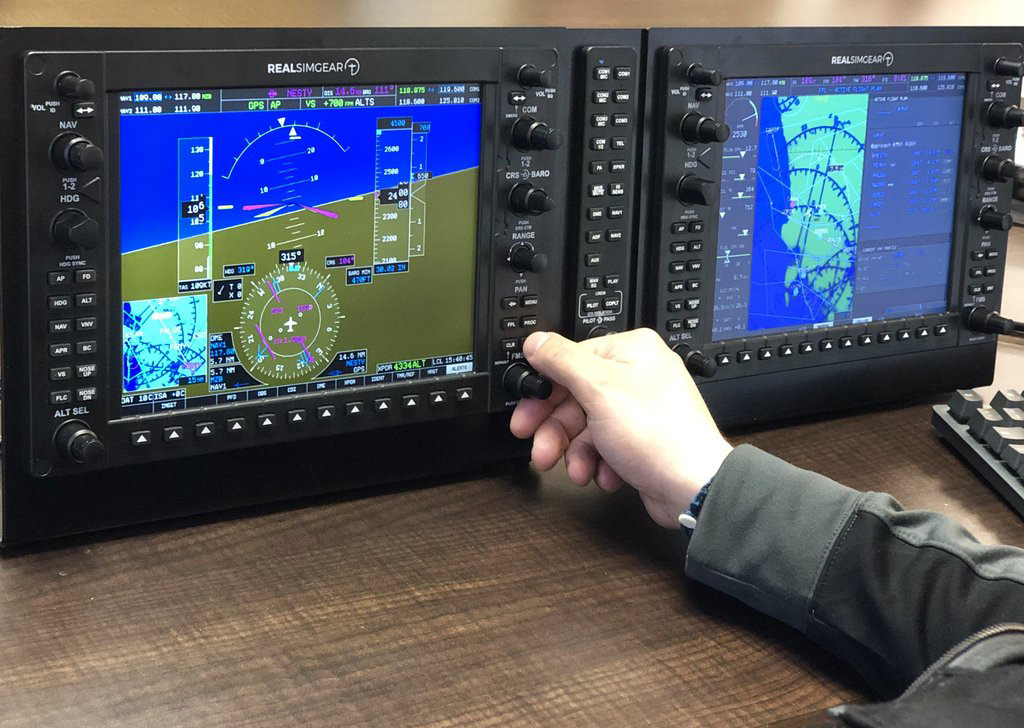Simulating a Bombing Raid in an F-16
The historic 1981 Israeli operation took out Iraq’s Osirak nuclear reactor.
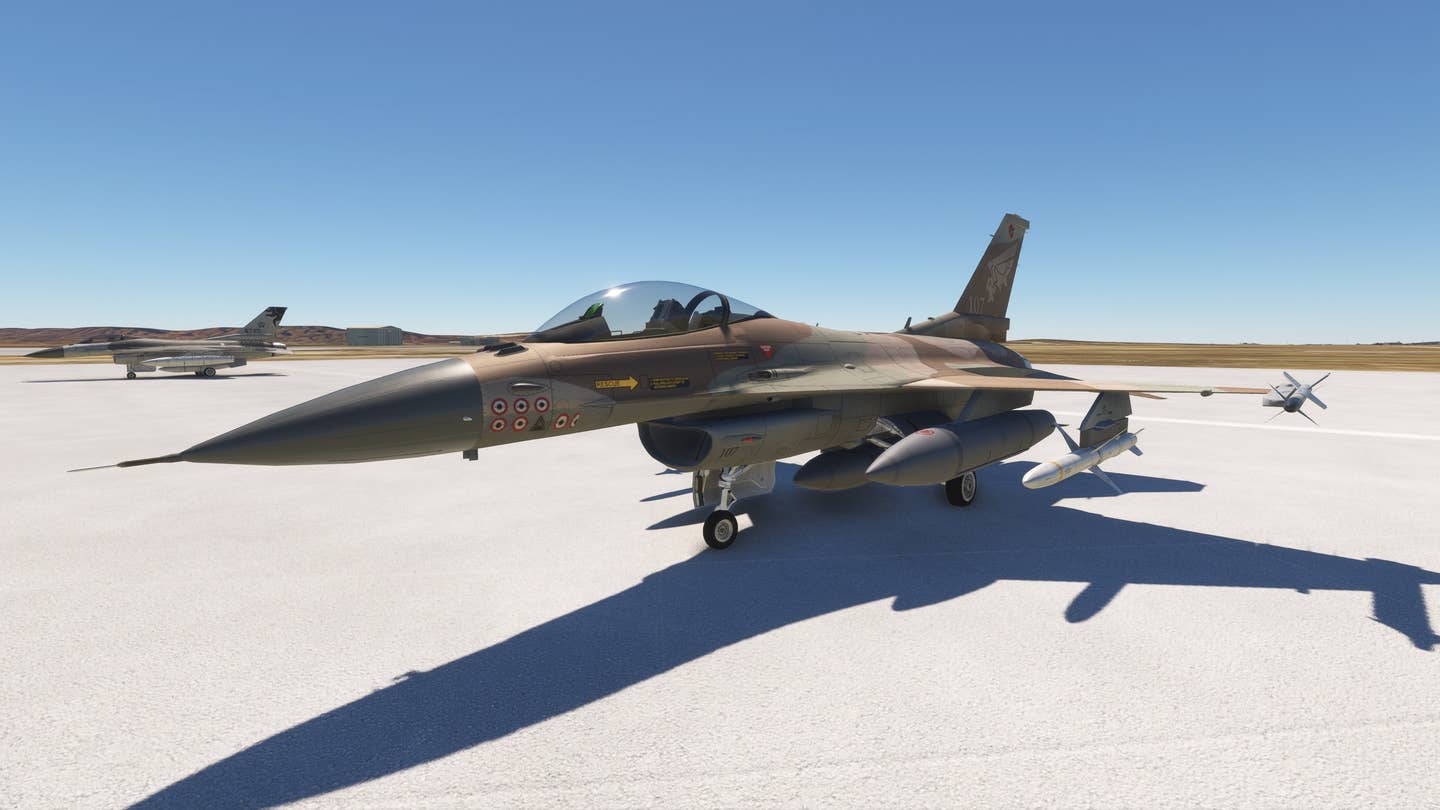
The F-16 is known as a fighter pilot’s fighter. [Courtesy: Patrick Chovanec]
Today in Microsoft Flight Simulator, I'll be checking out the F-16. And to get things rolling, I'll be flying one of its most historic missions: the 1981 Israeli bombing raid to take out Iraq's Osirak nuclear reactor.
Originally produced by General Dynamics, which has since sold its aircraft business to Lockheed Martin, the F-16 came about in the early 1970s in response to the shortcomings of the F-4 Phantom, which saw murderous attrition rates in the skies over Vietnam, and the introduction of new, more advanced Soviet fighters such as the MiG-25.
While the primary response took the form of the twin-engine F-15 Eagle, a "fourth generation" fighter billed as the ultimate air superiority fighter, a small cadre within the U.S. Air Force argued for also developing a smaller, single-engine fighter as a complement to the top-shelf (but expensive) F-15.
Known as the "Fighter Mafia," this group, led by Korean War fighter pilot John Boyd and mathematician Thomas Christie, developed a formula called "energy-maneuverability theory" to quantify and model a fighter's combat performance. Their theory called for an agile, lightweight fighter that could make fast changes in direction to get inside the enemy's decision-making loop.
The project gave rise to a competition, which ultimately came down to two contenders: the General Dynamics YF-16 and the Northrop YF-17. In part because it shared the same engine with the F-15, the Air Force chose the F-16. But the YF-17 didn't fade into history as it went on to become the Navy's F-18 Hornet.
The F-16 that the Fighter Mafia inspired was immediately recognizable as a fighter pilot's fighter. The bubble canopy provided unobstructed views in every direction, while the seat angled back 30 degrees to mitigate the effect of G-forces on the pilot.
The heads-up display (HUD), press-button display screens, and automated start-up checklist all simplified tasks for the pilot. The F-16 was the first fighter that was fly-by-wire. The traditional stick, mechanically connected to aircraft's controls, was replaced with a sidestick—almost like a gaming joystick— from which gentle nudges are enough to transmit electronic instructions to the computerized flight control system.
Computerized flight control was a necessity as well as a convenience, because the F-16 was designed to be aerodynamically unstable to maximize agility. Its single Pratt & Whitney F-100 turbofan produces a thrust-to-weight ratio greater than 1-to-1, boosting its maneuverability even further.
The wings and belly featured 11 hard points for attaching a wide array of missiles, bombs, extra fuel tanks, and electronics pods—up to 8 tons worth—for different types of missions. Unlike the F-4 Phantom, which initially lacked any guns for close-in dogfighting, the F-16 was also armed with a 20 mm M61 Vulcan six-barrel rotary cannon on the left shoulder of the cockpit, capable of firing 100 rounds per minute.
Dubbed the "Fighting Falcon" by General Dynamics, the F-16 quickly became known to its pilots and crew as the "Viper." Perhaps its profile reminded them of a snake ready to strike, but for many, it also called to mind the Viper starfighters in the original Battlestar Galactica TV series.
Overall, the F-16, was about a quarter the size of the F-15, about a third the weight, and initially cost $12.7 million per airplane, less than half the $28 million sticker price for an F-15—a fact that made it immediately attractive to export customers looking to buy a modern multipurpose fighter.
With General Dynamics' production facility in Fort Worth, Texas, gearing up to deliver a large initial order for the U.S. Air Force, one of the first American allies to place an order was the Shah of Iran. But when Islamic revolutionaries overthrew the shah and took U.S. diplomats hostage, that order was placed on hold, and the airplanes were offered to Israel instead.
For the Israelis, the F-16s were a godsend, because they already had a mission in mind for them. It's the mission we're preparing to depart on, at about 3 o'clock in the afternoon on June 7, 1981, at Etzion Airbase—now Taba International Airport (HETB) in Egypt—in the then-Israeli-occupied Sinai peninsula.
The target—nearly 1,000 miles away—was the Osirak nuclear power plant on the southeast outskirts of Baghdad. Purchased from the French, protected by sand berms and dozens of advanced antiaircraft missiles, the huge project was nearly ready to go online and start producing plutonium for an Iraqi nuclear bomb that Israel's leaders viewed as a mortal threat.
There were eight F-16s in the strike force, and I'm flying tail number 107. Originally, it was going to be flown by strike leader Zeev Raz, but he worried that something might be wrong with its navigation system, so he turned it over to his wingman, Amos Yadlin.
To have any chance of reaching their target and returning, the F-16s are heavily laden with extra fuel tanks mounted on each wing (compatible with ones the Israelis already used for their F-4s), as well as centerline fuel tanks they were able to urgently wheedle out of an unwitting Pentagon.
To lighten the load, they tossed out all the electronic countermeasure (EC) equipment normally used to protect against surface-to-air missiles (SAMs) and carried only a single heat-seeking Sidewinder air-to-air missile on each wingtip, as well as two 1,000-pound dumb bombs, one under each wing. (I can't depict bombs here, so their place is taken by HARM missiles).
The F-16's range was being stretched to its very limit. As they waited on the ramp for the word to take off, each F-16 was "hot refueled"—topped off with fuel while its engine was running—a highly dangerous procedure.
The airplanes were well over their maximum takeoff weight and would take the entire length of the 13,000-foot (4,000-meter) runway to lift off. At 4 p.m., the order came, and one by one the F-16s, on full afterburner, began their excruciatingly slow roll down the runway. And the F-16 is off on its very first flight in anger...
From the Sinai, the airplanes will skirt Jordanian airspace, flying across the Saudi Arabia desert to reach Iraq. To avoid radar detection—and interception by the Jordanian, Saudi, or Iraqi air forces—we'll fly the entire route there at just 100 feet above ground level. That means we must immediately descend from Etzion Air Base (at 2,415 feet above sea level) to the Gulf of Aqaba on the Red Sea.
By sheer coincidence, King Hussein of Jordan happened to be out on his yacht in the Gulf and watched in shock as the eight low-flying F-16s thundered right over him. While their Israeli markings had actually been removed, he immediately guessed they were an Israeli strike bound for Osirak. Hussein called to alert his country's air defenses and pass the word to Baghdad, but apparently the message never got through.
Within minutes, the airplanes had crossed—otherwise undetected—into Saudi Arabia, where they followed the twisting route of the waddis (dry desert ravines) through the coastal mountain range.
Practicing for the mission had posed quite a challenge, because the distance was far longer than Israel's entire length. They had to run multiple laps from the northern border with Lebanon down to the tip of the (then-occupied) Sinai and out over the Mediterranean Sea to simulate the mission.
While the Israeli pilots were all combat veterans, they were used to brief sorties to Israel's threatened borders and back—rarely more than an hour in the cockpit from start to finish. In training, they found the experience of flying long distances extremely fatiguing.
The concentration required to fly at just 100 feet off the ground at 360 knots for nearly 90 minutes to Baghdad was exhausting. I'm flying so low, at times, that I'm kicking up a cloud of dust behind me.
Apparently undetected, we can send back the one-word radio transmission, "Moscow," that will inform our superior waiting anxiously back at Etzion that we have reached roughly a quarter of the way to Baghdad.
In a few more minutes, we face a moment of truth. To reduce weight and conserve remaining fuel, we must jettison the empty auxiliary tanks under our wings. However, this has never been done before at these speeds and altitudes next to live bombs. The technicians say it should work, but there's also a chance the tanks, once released, could topple over the wings and damage the controls or bang into and set off the bombs next to them. As it turns out, though, the jettison goes smoothly, and the wing tanks fall harmlessly into the middle of the Saudi desert. Without their weight, the F-16s speed up slightly to around 380 knots.
Mile after mile of trackless desert passes just 100 feet below. Almost 45 minutes into our flight, as we hurl ourselves closer to the Iraqi border, it's time to transmit the one-word code, "Zebra," which indicates we are half of the way to our target—right under the noses of Saudi radar. There are no landmarks to indicate that we've crossed into Iraqi airspace, except for the sun gradually moving lower in the sky. Baghdad is an hour ahead of Israel, and the strike is planned to hit right around dinnertime.
Suddenly, out of the desert, a vital mission landmark: the Bahr al-Milh ("Sea of Salt"), also known as Lake Razazza, a vast artificial body of water created in the 1970s to contain the overspill from the Euphrates River about 60 miles southwest of Baghdad. An island in the lake is supposed to serve as the initial point (IP), where the pilots will arm their bombs and begin the attack sequence. But because of fluctuating water levels, the critical island is submerged and nowhere to be seen, and this has thrown trike commander Raz, off his stride. There's little time to absorb this as the F-16s cross the Euphrates River and enter the famed Fertile Crescent. Six F-15 fighters that have escorted the F-16 strike force now streak upward to 20,000 feet to provide air cover and electronic jamming for the bombing run. That—and their own speed—are the only real defense the F-16s will have.
The attack itself plays out in a matter of seconds. At a designated point 4 miles northwest of the target, we punch the afterburners and pop up in a climb, taking us to roughly 8,000 feet. To avoid negative Gs, we roll inverted at the top. At this moment, Yadlin (in our plane, 107) realizes that Raz, who was supposed to be first, has overshot the target and is starting a loop to come up and over behind him.
Not delaying a moment, Yadlin begins his bombing run, aiming at a 30-degree dive straight toward the Osirak reactor. At roughly 3,500 feet, with his HUD's target indicator directly on the dome of the reactor, he releases his bombs...
...and, to avoid both the ground and the (delayed-fuse) blast, punches the afterburner and pulls up immediately into a steep-turning climb to the left. While the rest of the F-16s drop their bombs in turn, we fly as fast and high as possible, straining right up to the airplane's 9G limit.
In fact, the strike had caught the Iraqi air force and air defenses sleeping. While later waves caught some antiaircraft fire, not a single Israeli F-16 was hit. At least eight of the 16 bombs they carried scored direct hits on the Osirak reactor, completely destroying it. Ten Iraqi soldiers and one French nuclear technician were killed, mostly by misdirected ground fire. The raid had lasted a total of two minutes.
Reassembling at 30,000 feet over Baghdad, the F-16s expected to be pursued by Iraqi fighters, but not one took off. Instead, the element of surprise obliterated, they climbed to 38,000 feet for the return trip home. Flying at higher altitude in thinner air would help conserve the fuel they needed for the task. Rather than fly at 40,000 feet as planned and face a headwind, they stay at 38,000 even though that creates a visible contrail in the moister air.
Tired but elated, they made a direct beeline across Jordanian airspace, hoping they would be long gone before fighters could scramble to high altitude to intercept them. Finally, as the sun set, they crossed back into Israeli airspace and initiated their landing patterns back at Etzion Air Base. All eight F-16s returned unscathed, with barely a drop of fuel left in their tanks. The daring success of the raid stunned both Israeli's enemies and allies and earned the F-16 its combat spurs.
The markings you may have noticed on the nose of 107 show the Osirak raid plus 6.5 later air-to-air kills against Syrian MiGs and helicopters in Lebanon. The airplane is currently displayed at the Israeli Air Force Museum in Hatzerim. For details of the mission, I highly recommend the book Raid on the Sun by Rodger Claire.
The U.S. Air Force ordered more than 2,200 F-16s, which served on the front lines of the Cold War as well as both wars with Iraq and no-fly zones over Iraq, Yugoslavia, and Libya. Most F-16s are single-seat fighters, but every order usually comes with a few two-seat variants, either for flight instruction or more complex, demanding missions. The earliest round of F-16s were designated A (single seat) and B (two seat), while later, upgraded versions of the airplane were designated C/D and E/F, each with its one-seat and two-seat variants.
Most U.S. F-16s are painted various shades of gray. This particular aircraft was given a special "desert camouflage" paint job to commemorate the first air-to-air kill by an F-16 in U.S. Air Force service during Operation Southern Watch.
After the first Gulf War, Saddam Hussein used his air force to strafe and bomb uprisings against him by Kurds in the north and Shiites in the south. In response, the United Nations passed a resolution authorizing coalition aircraft to enforce a no-fly zone over both parts of the country. On December 27, 1992, an Iraqi MiG-25 crossed into the southern no-fly zone, only to find itself trapped by a group of F-16s of the 33rd Fighter Squadron led by then-Lieutenant Colonel Gary North. North fired an AIM-120 AMRAAM missile that took down the MiG. It was not only the first kill for an F-16 in U.S. Air Force service but the first for the new AIM-120 missile as well.
The message was sent and received. After that, Air National Guard and active-duty squadrons rotated through the region, patrolling the skies over Iraq for more than a decade until the invasion of Iraq in 2003. The role of the F-16 in the skies over Iraq complemented the F-15. While the F-15 tended to operate above 15,000 feet, focusing on air superiority, the F-16 made optimal use of its power and agility at lower altitudes to perform a variety of missions, from lower-level interdiction to bombing and strafing enemy units on the ground.
One of the most dangerous missions the F-16 performed was pairing with older F-4s as "Wild Weasels," whose job it was to find and destroy SAM sites. In this case, they did use the AG-88 HARM missile, referred to when fired as "Magnum." F-16 pilot Dan Hampton related his colorful experiences as a Wild Weasel over Iraq—including with the 77th Fighter Squadron "Gamblers" depicted above—in his memoir Viper Pilot.
Meanwhile, back home, since 1983 the F-16 has been the public face of the U.S. Air Force, flown by its Thunderbirds demonstration team that performs aerobatics at sports games and other major events.
In popular culture, the F-16 was also featured in the 1984 action-adventure film Iron Eagle, starring Louis Gossett Jr.. The movie fared poorly against the far more popular Top Gun than year. Interestingly, Iron Eagle was filmed in Israel using Israeli F-16s, because (unlike the Navy) the U.S. Air Force refused to sign on to the movie.
At the real Top Gun, the Navy has recruited the F-16 to play "aggressor" against its own top pilots, at its new location at NAS Fallon in Nevada. So has the U.S. Air Force at its own exercise range at Nellis AFB in Nevada. Even the U.S. Space Force now has its own squadron of aggressor F-16s.
Top Aces, a private company founded by Canadian fighter pilots, recently purchased a batch of older F-16s from Israel. From its operating base in Mesa, Arizona, the company has contracts with Canada, Germany, and Australia to provide "aggressor" training for their air forces.
Meanwhile, starting in 2003, Israel has ordered 102 of its own specially designed F-16I model, dubbed "Sufa,meaning "Storm". All of them are two-seaters and feature a distinctive "spine" carrying a suite of electronics and equipment uniquely suited for Israeli Air Force needs.
Besides the U.S. and Israel, 24 other countries have purchased the F-16. One of the earliest to do so was Pakistan in the wake of the 1979 Soviet invasion of Afghanistan. During the 1980s, Pakistani F-16s shot down several Soviet aircraft intruding over the border from Afghanistan. However, in response to Pakistan's pursuit of a nuclear bomb to rival India, starting in 1990 the U.S. imposed sanctions on Pakistan. New aircraft were impounded, and spare parts for existing airplanes were cut off, effectively grounding Pakistan's F-16 fleet.
These sanctions were quickly tossed aside in the wake of the 9/11 attacks in 2001. Pakistan now fields a total of 75 new and upgraded F-16s as its primary fighter. It has fought in both air-to-air battles with India's mainly Russian-designed aircraft and in ground bombing operations against Taliban militants in places like the Swat Valley.
The world's third largest user of F-16s, after the U.S. and Israel, is Turkey, which boasts a total of 245. Only the first eight of these, in fact, were made in the U.S. Along with Belgium, the Netherlands, and South Korea, Pakistan manufactures its own F-16s under license from Lockheed Martin, though they are regulated under U.S. arms export laws. Turkish F-16s have been used extensively in bombing campaigns against Kurdish rebels, as well as aerial skirmishes during the Syrian civil war. Most notably, one shot down a Russian Air Force Su-24 along the Turkish-Syrian border in 2015.
Like many countries fielding F-16s, Turkey hoped to replace it with the new F-35, placing an initial order for 30. However, the U.S. Congress, angered at Turkey's purchase of the Russian-made S-400 air defense system, barred F-35 sales to Turkey. While the U.S. has offered to use Turkey's $1.4 billion payment (already made) to upgrade its F-16s, the Turkish government has announced that it is working on its own homegrown, fifth-generation jet fighter, called the TF Kaan, to replace its F-16s as well as for export.
Greece also maintains a sizable fleet of F-16s, 135 total. Although they are both NATO allies, tensions between Greece and Turkey have led to a striking occurrence: "mock" dogfights between the two countries' F-16s that are intense enough to lead to tragedy. In May 2006, two Greek F-16s intercepted a Turkish reconnaissance airplane along with its two F-16 escorts off the Aegean Sea island of Karpathos. A dogfight ensued in which a Greek F-16 and Turkish F-16 collided. The Turkish pilot ejected safely, but the Greek pilot was killed.
Speaking of international tensions, some of the most hotly contested sales of F-16s over the years have been to Taiwan. During a visit there, I was able to spot several of them taxiing to and from their protective concrete bunkers while arriving at Hualien Airport (RCYU) on the island's east coast.
The Republic of China on Taiwan, which the Chinese government sees as a rebel province and many view as a vital U.S. ally, has accumulated a fleet of roughly 150 F-16s, starting in the early 1990s. Each time the U.S. sells more F-16s to Taiwan, upgrades existing ones, or sells the advanced missiles they use, it must weigh the boost to Taiwan's defenses (to aid in a long-awaited Chinese invasion) versus the risk of upsetting relations with Beijing. In recent years, however, with U.S.-China tensions on the rise, the instinct in Washington, D.C., has been to give Taiwan more of the weapons it wants, including (in 2019) 66 new aircraft plus upgrading older A/B models to the improved F-16V.
If the F-16 I'm flying out of Hualien looks like it's wearing shoulder pads, those are conformal fuel tanks (CFTs), which make up part of the new upgrades and add to the F-16s range without an appreciable negative effect on aerodynamic performance. Several countries have adopted the CFTs for their F-16s, but somewhat curiously, the U.S. Air Force has not. Perhaps that’s because the F-16 plays a more specialized role as part of a much larger air force, especially as it is gradually phased out in favor of the F-35.
These days, Taiwan's F-16s are regularly scrambled to intercept Chinese incursions into the ADIZ (Air Defense Identification Zone) surrounding its airspace, an average of more than four per day in 2022. In fact, nearly 9 percent of Taiwan's entire defense budget now goes to responding to these incursions. If any actual invasion ever happened, Taiwan's F-16s would be at the pointy end of the spear, operating from secret and improvised airfields to contest air superiority and, ideally, strafe and bomb the Chinese landing forces until, the Taiwanese hope, U.S. forces could arrive and join them.
That day may or may not come, but with more and more U.S. allies in Europe looking to transition to F-35s, they are laying the groundwork for sending their F-16s to join the fight in Ukraine. The Netherlands, Denmark, and Norway have all pledged to send their surplus F-16s to Ukraine, and Ukrainian pilots have been training in Romania to fly them. So while this Ukrainian F-16 I'm flying over Kyiv might be fiction today, very soon it may be writing the latest epic chapter in the 40-plus year history of the Viper.
More than 4,600 F-16s have been produced, making it the world's most numerous fixed-wing aircraft in military service. I hope you enjoyed learning more about its ongoing story.
If you’d like to see a version of this article with more historical photos and screenshots, you can check out my original post here.
- READ MORE: Recreating the Final Flight of the Red Baron
Note: This story was told utilizing the F-16 add-on to Microsoft Flight Simulator 2020 by SC Designs, along with liveries and sceneries produced by fellow users and shared on flightsim.to for free.

Sign-up for newsletters & special offers!
Get the latest FLYING stories & special offers delivered directly to your inbox

